Marketers love discovering new communication and distribution channels to reach their customers. And that’s cool.
To stay on the top in such dynamic environment, you need to constantly seek for new solutions, test new approaches and strategies.
But, it doesn’t mean that we should take our eyes off the traditional methods, especially when they’re still bringing great results like email marketing.
In this article, we’ll take a closer look at some email marketing statistics to see what results you can achieve with it and what’s the future of this old (but still gold) marketing method.
In this article:
- Average open rates
- What is a good open rate for email?
- What is the average click-through rate (CTR) of email marketing campaigns?
- Click-to-open and unsubscribe rates
- Email marketing return on investment (ROI)
- Email marketing revenue stats
- Effectiveness of email automation
- Best metrics to measure email campaigns results
- Challenges marketers have to face
- B2B email marketing
- Welcome emails statistics
Learn how to automate your email marketing campaigns easily
If you want to discover more about this subject, check these out:
- 10 Best Email Marketing Templates & Designs
- 10 Best Email Marketing Software and Services
- 6 Tips to Use Analytics For Effective Email Marketing
Let’s start from the top—
What is email marketing?
Email marketing is a marketing channel that uses email communication to promote your company’s products, services, increase brand awareness and customer engagement. It also helps in building a relationship with your clients—thanks to its direct character, it’s a great way to keep your clients informed on your latest offers, give them discounts for your services, etc.
Email marketing can be done in two ways. You can use third-party platforms for sending campaigns, such as Mailchimp, HubSpot, or Sender, or do it in-house. But whichever approach you choose, it’s always good to know the benchmarks and what results you can expect from the email marketing campaigns.
Here’s the list of top email marketing stats that will help you with it.
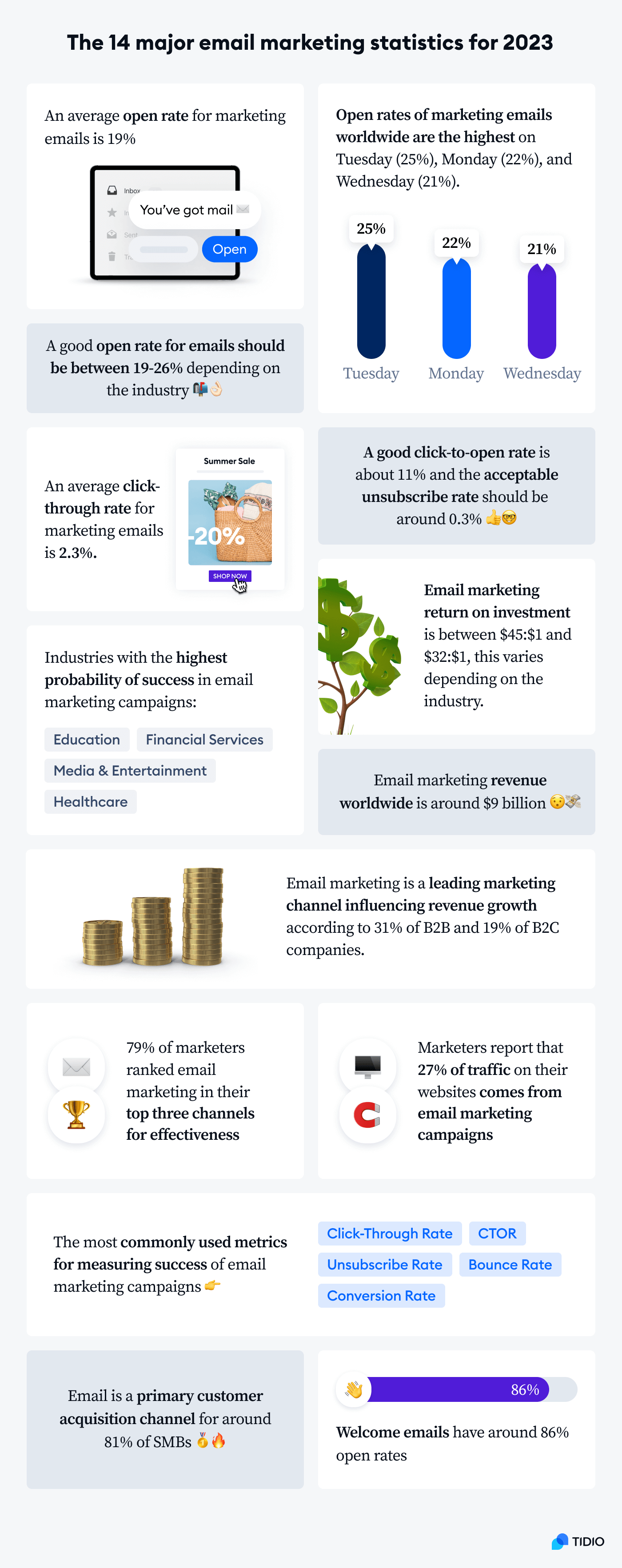
Let’s start with answering the question “what’s a good open rate for emails?”
1. Email marketing average open rate

The average email open rate for marketing campaigns is about 19% globally.
Open rate is, together with click-through rate, the most important metric that defines the success of your email marketing campaigns. And to achieve a high open rate, you need to pay close attention to your subject lines and time for sending your emails.
In order to gain higher open rates, make sure that your subject line includes the following essential elements:
- Urgency
- Curiosity
- Offers
- Personalized subject lines
- Relevance and timeliness
- Name recognition
- Popular stories
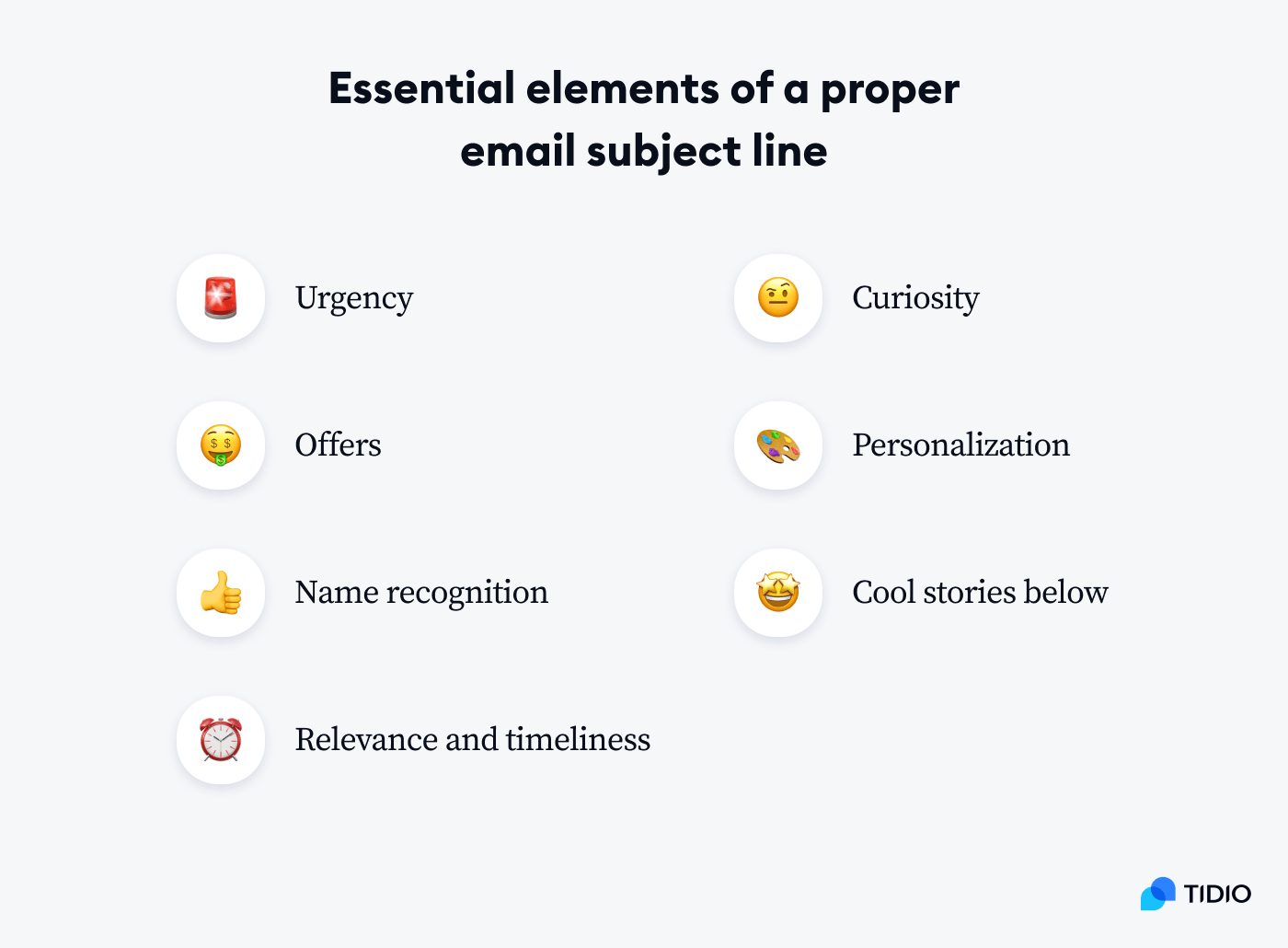
How about emojis in headlines?
When it comes to emojis in subject lines and their influence on open rate—it all depends. Although they may catch your responders’ attention, it doesn’t mean that they will get people to read the whole piece.
According to research, emojis can even lower your open rates by 6% and increase unsubscribe rates by over 40%. But, as mentioned before, it depends on many different aspects. This includes the industry you operate in, the formality of your emails, your audience preferences, etc.
So, if you are planning an email marketing campaign for a financial institution, emojis in subject lines may not be the best idea. But, if your company’s communication form is more informal and direct, feel free to test them out.
Another important aspect of a successful email marketing campaign you should consider is the right time for sending your promotional emails.
So, what is the average open rate for email marketing on different days and hours?
Open rates of marketing emails worldwide are the highest on Tuesday (25%), Monday (22%), and Wednesday (21%).
Also, a trend presents that the highest engagement for marketing emails occurs at 9am-12pm (24%), 12pm-3pm (27%), and 3pm-6pm (18%). Whereas the lowest is at 6am-9am (11%), 6pm-9pm (6%), and 9pm-12am (1%). This shows us that the best time for sending marketing emails is between 9am and 3pm during the first three days of the workweek.
Read more: Learn more about the best time to send emails and get some tips and tricks to increase your open rates.
2. What is a good open rate for email?
| Industry | Open rates |
|---|---|
| Advertising & Marketing | 20.5 % |
| Agriculture, Forestry, Fishing, Hunting | 27.3 % |
| Consumer Packaged Goods | 20 % |
| Education | 28.5 % |
| Financial Services | 27.1 % |
| Restaurant, Food & Beverage | 18.5 % |
| Government & Politics | 19.4 % |
| Healthcare Services | 23.7 % |
| IT/Tech/Software | 22.7 % |
| Logistic & Wholesale | 23.4 % |
| Media, Entertainment, Publishing | 23.9 % |
| Nonprofit | 26.6 % |
| Other | 19.9 % |
| Professional Services | 19.3 % |
| Real Estate, Design, Construction | 21.7 % |
| Retail | 17.1 % |
| Travel, Hospitality, Leisure | 20.2 % |
| Wellness & Fitness | 19.2 % |
In general, a good email open rate should be between 19-26%. Of course, this score depends on the average benchmark for industry you’re in, subject line, and the quality of your recipients list.
So, in which industries you can expect the best results of email marketing campaigns?
The top 3 highest open rates for business emails were observed in:
- Education—28.5%
- Agriculture, forestry, fishing and hunting—27.3%
- Financial Services—27.1%
Just below them are:
- Nonprofit organizations—26.6%
- Media, publishing, entertainment—23.9%
- Healthcare services—23.7%
Whereas the lowest results were spotted in:
- Wellness and fitness—19.2%
- Restaurant, food and beverage—18.5%
- Retail—17.1%
As the statistics above represent a general number for each industry, treat them like a starting point and observe your audience. Every company can succeed from email marketing, but, as this form of communication is very direct, you need to find your own sweet spot that will best resonate with your audience.
The best way to find it is to test various approaches and strategies. Try new subject lines, experiment with the length of your emails, sending times, and see what brings you the best results.
3. What is the average click-through rate (CTR) of email marketing campaigns
Click-through rate (CTR) is a metric that measures how many people clicked on a hyperlink, CTA, or linked image in your email. The main goal of tracking click-through rate is to measure and analyze engagement your emails generate. Thanks to this analysis, you can improve most important elements of your messages, including:
- Email content (written and design)
- Media type
- Link count
- Link placement
- Overall brand interest
As CTR is expressed in percents, it’s a great metric showing what percentage of your audience is in your content and visits your website or clicks in your campaign found in the email. So, what is the average CTR for marketing emails?
| Industry | Click-through rate |
|---|---|
| Advertising & Marketing | 1.8 % |
| Agriculture, Forestry, Fishing, Hunting | 3.4 % |
| Consumer Packaged Goods | 1.9 % |
| Education | 4.4 % |
| Financial Services | 2.4 % |
| Restaurant, Food & Beverage | 2.0 % |
| Government & Politics | 3.8 % |
| Healthcare Services | 3.0 % |
| IT/Tech/Software | 2.0 % |
| Logistic & Wholesale | 2.0 % |
| Media, Entertainment, Publishing | 2.9 % |
| Nonprofit | 2.7 % |
| Other | 2.6 % |
| Professional Services | 2.1 % |
| Real Estate, Design, Construction | 3.6 % |
| Retail | 0.7 % |
| Travel, Hospitality, Leisure | 1.4 % |
| Wellness & Fitness | 1.2 % |
The general average CTR for marketing emails is 2.3%.
And what are the stats by industry?
The highest CTR was observed in Education (4.4%), Real Estate, Design and Construction (3.6%), Agriculture, Forestry, Fishing and Hunting (3.4%), and Healthcare Services (3%).
Whereas the lowest CTR was spotted in Consumer Packaged Goods (1.9%), Advertising & Marketing (1.8%), Travel, Hospitality and Leisure (1.4%), Wellness & Fitness (1.2%), and Retail (0.7%).
But remember—opening an email is great as it improves your brand awareness and customer communication, which indirectly could lead to more sales. CTR can help you analyze and boost the engagement of your messages. But it doesn’t bring you any profit per se.
Let’s find out the average ROI for email marketing.
4. Other email marketing statistics by industry
| Industry | Click-to-open rates | Unsubscribed rates |
|---|---|---|
| Advertising & Marketing | 9.0 % | 0.2 % |
| Agriculture, Forestry, Fishing, Hunting | 12.5 % | 0.3 % |
| Consumer Packaged Goods | 11.1 % | 0.1 % |
| Education | 15.7 % | 0.2 % |
| Financial Services | 10.1 % | 0.2 % |
| Restaurant, Food & Beverage | 10.5 % | 0.1 % |
| Government & Politics | 14.3 % | 0.1 % |
| Healthcare Services | 13.4 % | 0.3 % |
| IT/Tech/Software | 9.8% | 0.2 % |
| Logistic & Wholesale | 11.7 % | 0.3 % |
| Media, Entertainment, Publishing | 12.4 % | 0.1 % |
| Nonprofit | 10.2 % | 0.2 % |
| Other | 13.2 % | 0.3 % |
| Professional Services | 11.1 % | 0.2 % |
| Real Estate, Design, Construction | 17.2 % | 0.2 % |
| Retail | 5.8 % | 0.1 % |
| Travel, Hospitality, Leisure | 8.7 % | 0.2 % |
| Wellness & Fitness | 6.0 % | 0.4 % |
Another two important metrics in email marketing are click-to-open and unsubscribe rates.
Click-to-open rate (CTOR) measures the percentage of people who opened the email and then clicked a link within that email.
A good CTOR for all industries is about 11%.
But, in Real Estates, Education, and Government, these metric is significantly higher in comparison to the rest. When we combine this metric with the Open Rates, CTR and unsubscribe rate (the percentage of email addresses that unsubscribe from an email marketing campaign) we can assume that Education, Financial Services, Media & Entertainment and Healthcare services are the industries with the highest probability of success in email marketing campaigns.
5. Email marketing ROI: statistics

So, what is the average ROI on email marketing?
Email marketing ROI varies between $45:$1 and $32:$1 with the average $36:$1, depending on the industry.
Retail and ecommerce companies enjoy the largest return on investment from their email marketing. For every $1 they spend, on average, they can expect to receive $45 in return. Whereas the lowest score ($32:$1) was reported in the media, publishing, events, sports & entertainment industry.
Also, you should be sending out personalized emails to increase your profits, since they generate around six times higher transactions than general newsletters.
But is the ROI of email marketing the highest of all marketing channels?
Email marketing has one of the highest returns on investment of all digital marketing channels.
In comparison to the average $36:$1 that you can expect from your email campaigns, businesses make about $8:$1 for Google Ads. Another channel worth looking at is SEO, which brings back about $12:$1.
It’s important for your business to start email campaigns as early as possible to sway the customer’s purchase decisions in your direction and increase sales. You can also consider organic search, direct marketing, and paid search since their ROI are also quite high.
Moving forward—how much money does email marketing bring to your business?
6. Email marketing revenue statistics
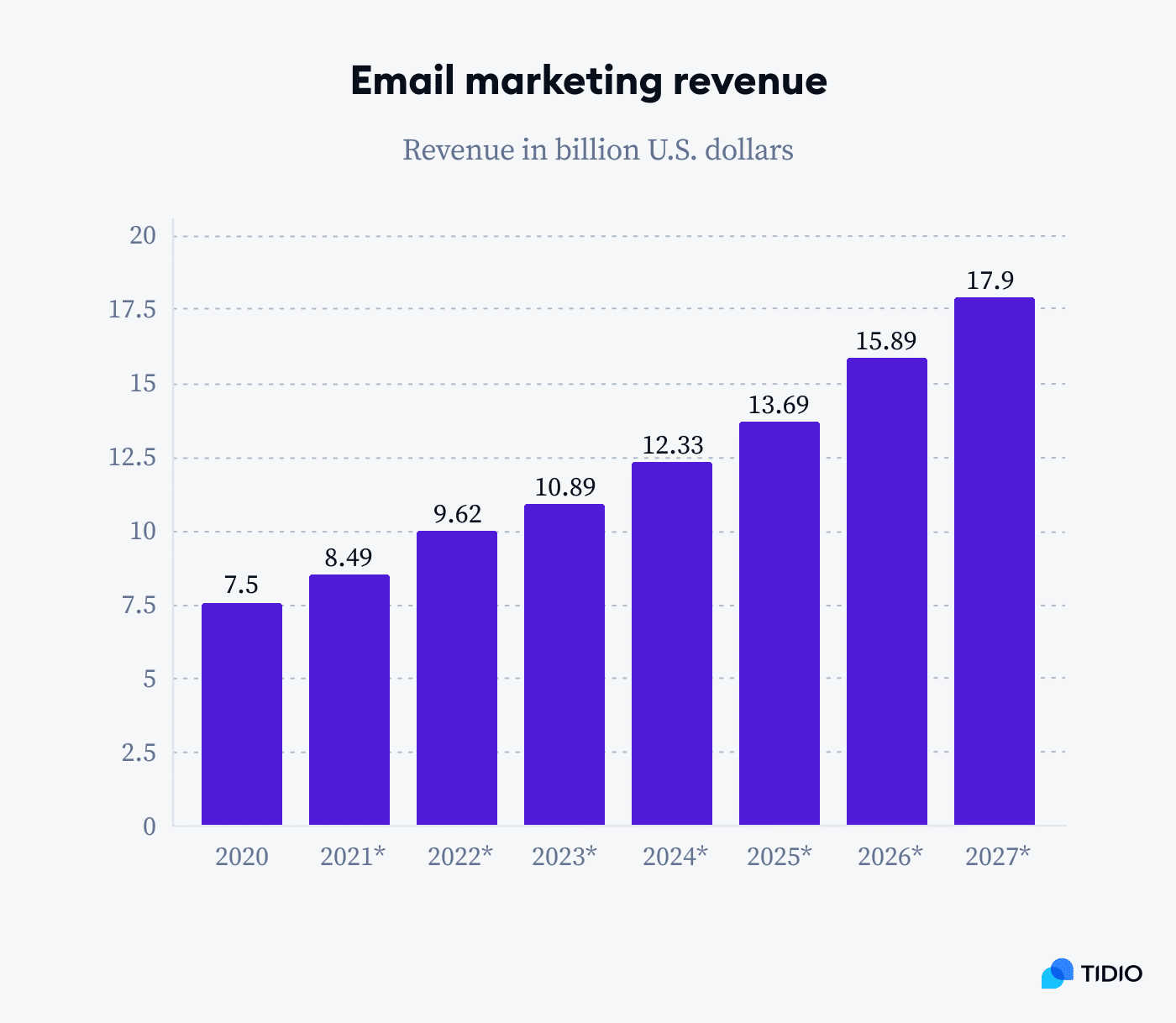
Email marketing worldwide revenue is predicted to grow from $7.5 billion in 2020 to nearly $18 billion in 2027.
The number of email users is growing every year. Also, more companies are embracing email marketing tools and discovering the power of email campaigns, so it should come as no surprise that the revenue from this channel is increasing as well. The more people receive your newsletters, the more likely they are to open them, click through to your website and make a purchase.
Email marketing is a leading marketing channel influencing revenue growth according to 31% of B2B and 19% of B2C companies. What’s more, 37% of brands already decided to increase their email budget.
Ok—there’s a huge revenue opportunity there, but you need a bigger picture to decide if it’s worth the effort. So, how is email marketing effective?
7. Effectiveness of email marketing: statistics
As many as 95% of marketers say that email marketing was an outstanding channel in meeting their business goals, and 79% of them ranked email marketing in their top three channels for effectiveness.
Also, marketers report that 27% of traffic on their websites comes from email marketing campaigns.
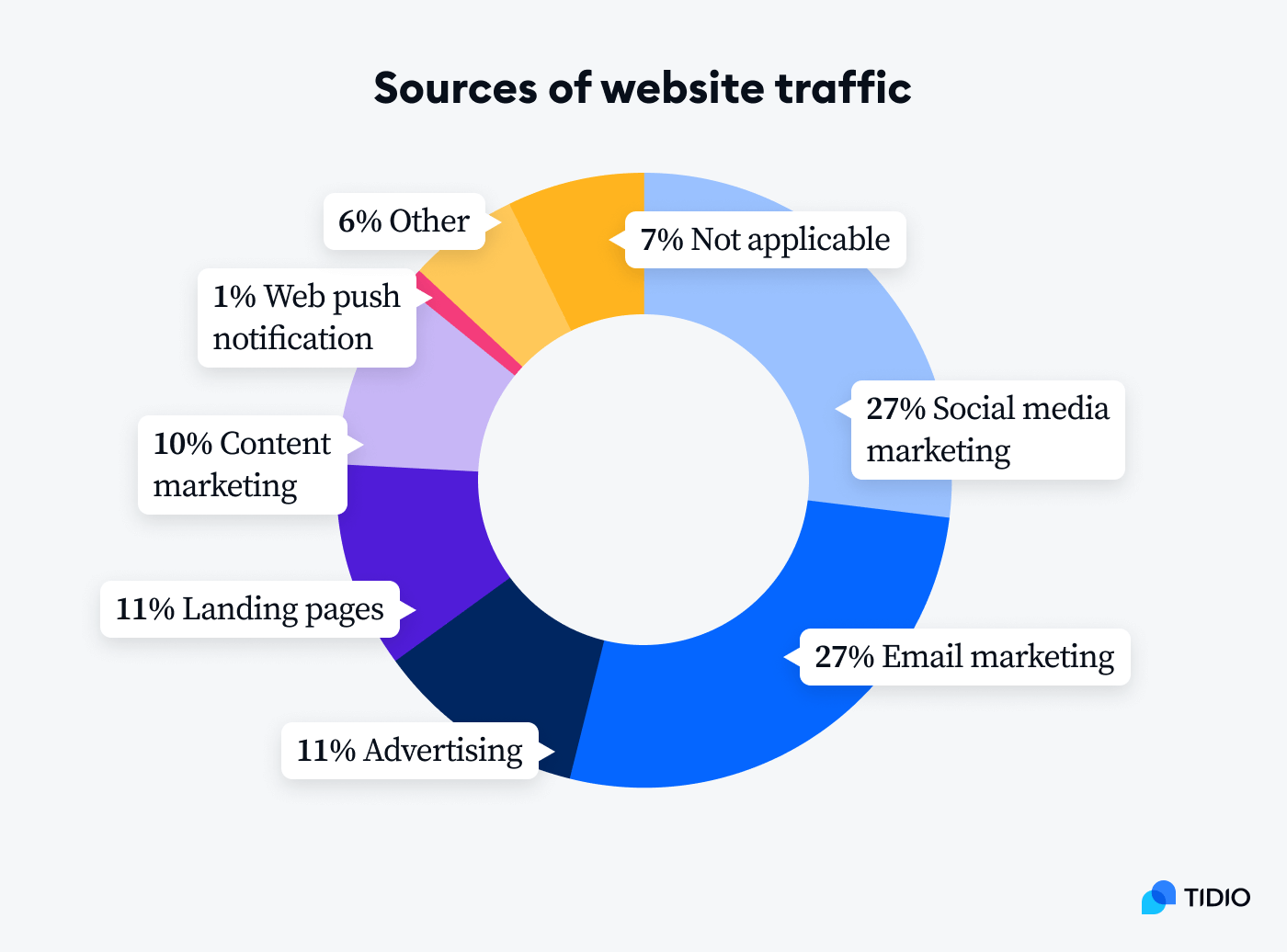
So, if you were wondering “is email marketing effective”, then yes—it is. Moreover, this data suggests that email is an essential part of a digital marketing strategy. This doesn’t mean, though, that it’s enough to use only one marketing channel. You should always consider adding more than one type of advertising to your tactics to increase their effectiveness.
Social media marketing scores second highest at 19% effectiveness. However, consider that about 20% more Millennials prefer to receive updates and promotions from a company via email than social media. So, spread the company name on social media platforms via posts and ads to collect leads and gain more email subscribers for your campaign automation. But keep the majority of your communication on email.
Automate your email marketing campaigns easily
Read more: Discover how to create an effective email newsletter from scratch and check out the best email newsletter templates.
These are the metrics you should consider. But what benchmarks should you utilize to see if your company is doing better or worse in comparison to the competition? Does email marketing bring better results in some industries than others?
Let’s find out!
8. Metrics of email marketing: statistics

The most popular and most commonly used metrics for measuring success of email marketing campaigns are:
- Open rate (95%)
- Click-through rate (88%)
- Unsubscribe rate (73%)
- Click-to-open rate (68%)
- Bounce rate (56%)
- Conversion rate (55%)
When planning and proceeding with an email marketing campaign, it’s recommended to use diverse metrics to discover how successful your approach was and what you can improve. The best metrics to keep track of are CTRs, open rates, conversions, bounce rates.
Around 18% of content marketers track email read time and 37% measure email subscribers list growth.
These two are also important for marketers worldwide to decide which content attracts and engages the audience the most. Knowing these metrics can help you with customer segmentation and ensure that you’re targeting the right group of people with the interesting content. As a result, it can improve your email marketing automation efforts.
Okay—this looks like a win for email marketing! It has a high ROI, brings large revenue, and it’s effective.
Now, let’s see what challenges marketers have to face when sending out emails and planning their next campaigns.
9. Email marketing stats: challenges
Maintaining an engaged email list is the most difficult objective to achieve when optimizing the email marketing strategy worldwide, according to 45% of marketers.
Reducing spam complaints (37%) and increasing the email list size (34%) take the second and third spots respectively. Only about 22% of marketers find optimizing for smartphones to be a difficult task.
Most marketers (66%) created a responsive email template as one of their efforts to optimize for mobile devices.
Other measures include adapting a simpler design and writing shorter email subject lines. All these efforts can decrease bounces and gain higher opens of your email campaigns. So, no matter if your subscriber uses a Gmail app, Outlook on their iPhone, or Yahoo on a laptop, they’ll get the same great experience.
Now—let’s say you overcome these challenges and send out your marketing emails to clients. What metrics should you use to measure the results of your efforts?
Let’s get a little bit more specific. Does your company operate in the B2B sector? What are some of the newsletter statistics specific to your business?
10. B2B email marketing statistics
Email marketing is considered the most effective marketing channel in driving conversions by 48% of B2B marketers.
These stats about email marketing show that it’s one of the most important promoting tactics for B2B marketers. In addition to that, the unique opens are at about 22% and an average click-through rate is about 6%. Not bad!
Email marketing is the leading content marketing type according to 77% of B2B marketers.
And how about open rates?
The average B2B email open rate is about 15%.
It’s important to consider what works for others when you’re making your plan. According to marketers, email is the second most important type of content marketing, right after blog posts. So, after you consider setting up a blog on your website, you should start thinking about your next email campaign.
Which type of email gets the best results? Cart abandonment? Newsletter?
No—you’ll actually get the highest open rates and conversions from a welcome email.
Read more: Learn more about how to avoid spam filters and improve email deliverability rates.
11. Welcome email statistics

Welcome emails have around 86% open rates.
This is almost 70% higher than the overall email marketing average open rate. So, putting resources into your welcome messages can be a perfect opportunity for your business.
Conversion rates reach 52% when it comes to automated welcome emails.
In comparison, product abandonment emails only get about a 17% conversion rate. So, welcome emails are one of the best ways to increase your sales and get the customer back into your store.
Read more: Learn how to schedule your email marketing campaign with Tidio.
Overall—does email marketing help businesses grow?
12. Email helps to grow your business
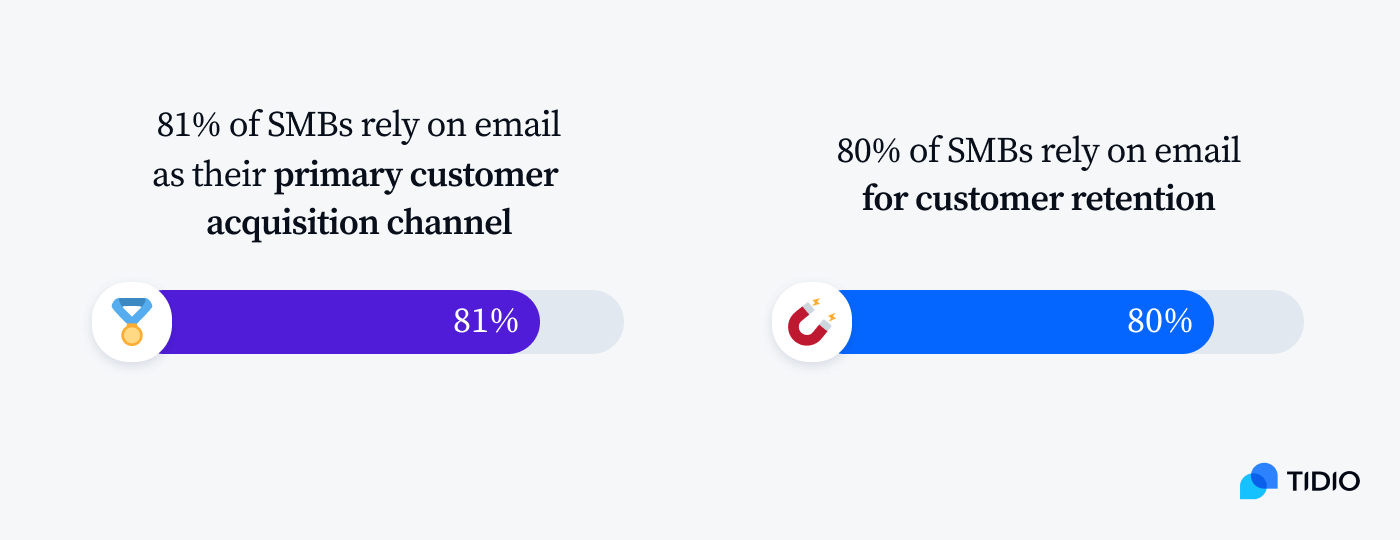
Email is a primary customer acquisition channel for around 81% of SMBs. Moreover, around 80% of them rely on email marketing for retaining clients.
These statistics about email marketing show that the majority of small businesses rely on it for their growth and customer retention. And if you decide to use emails but also incorporate other types of digital marketing into your strategy, you might be better off than 8 out of 10 of your competitors.
By using abandoned cart emails, your business can save up to 6% of sales.
This might not seem like a lot, but in the long run, it could be.
Let’s say that 100 of your potential customers per month leave without completing their checkout. Each of them has about $100 worth of your products in their virtual cart when exiting your ecommerce store. When you manage to save 6 out of 100 clients, and they complete the sale, that’s an additional $600 on your account every month.
Summary
Here are the major email marketing statistics and outcomes for 2023:
- An average open rate for marketing emails is about 19%.
- Open rates of marketing emails worldwide are the highest on Tuesday (25%), Monday (22%), and Wednesday (21%).
- A good open rate for emails should be between 19-26% depending on the industry.
- An average click-through rate for marketing emails is 2.3%.
- A good Click-To-Open I’m Rate is about 11% and the acceptable Unsubscribe Rate should be around 0.3%.
- Education, Financial Services, Media & Entertainment and Healthcare services are the industries with the highest probability of success in email marketing campaigns.
- Email marketing return on investment is between $45:$1 and $32:$1, this varies depending on the industry.
- Email marketing is a leading marketing channel influencing revenue growth according to 31% of B2B and 19% of B2C companies.
- 79% of them ranked email marketing in their top three channels for effectiveness.
- Email marketing revenue worldwide is around $9 billion.
- Marketers report that 27% of traffic on their websites comes from email marketing campaigns.
- The most popular and most commonly used metrics for measuring success of email marketing campaigns are Click-Through Rate, Unsubscribe Rate, CTOR, Bounce Rate, and Conversion Rate
- Email marketing is considered the most effective marketing channel in driving conversions by 48% of B2B marketers.
- Welcome emails have around 86% open rates.
- Email is a primary customer acquisition channel for around 81% of SMBs.
Sources:
- Worldometer
- Email Statistics Report, 2021-2025
- Ultimate Email Marketing Benchmarks for 2022: By Industry and Day
- Emojis in Email Subject Lines: Do They Affect Open Rates?
- In Engagement Shift, Friday Proves Top Day for Email Response Rates in 2020
- GetResponse: Email Marketing Benchmarks
- Litmus: The ROI of Email Marketing
- Experian Marketing Services study finds personalized emails generate six times higher transaction rates
- Google Economic Impact
- SEO ROI: How to Calculate the Value of Your SEO Investment
- ReportLinker: Global Email Marketing Industry
- Primary Revenue Driver
- 2020 Small Business Email Marketing Statistics
- Despite Inbox Competition, Marketers Confident in Email’s Effectiveness
- 2021 Digital Marketing Report for Entrepreneurs & Small Business
- As Marketers Plan a Rise in Email Volume, Keeping Lists Engaged Proves A Challenge
- How Marketers Can Adapt to Event Cancellations Brought on by Coronavirus
- Emfluence: Email Marketing Benchmarks
- Content Marketing Institute: B2B Content Marketing: Benchmarks, Budget, and trends
- Ecommerce Statistics Report 2020
- Emarsys: An SAP Report
- A Beginner’s Guide to Cart Abandonment Recovery
- Marketing Research Chart: How millennials and baby boomers want to receive updates and promotions
- 66% of content marketers ramped up production in 2021: Key opportunities and challenges | What’s New in Publishing
- What are good open rates, CTRs, & CTORs for email campaigns?
- 2022 Email Marketing Benchmarks by GetResponse
- The Best Time to Send an Email [Research]
- Email Open Rates By Industry (& Other Top Email Benchmarks)
- Ultimate Email Marketing Benchmarks for 2022: By Industry and Day
- 10 Email Marketing Statistics You Need to Know
- Google Economic Impact
- Email Marketing Strategy: Insights From the 2021 State of Email Report
- State of Marketing Trends Report 2022
- 2021 Digital Marketing Report for Entrepreneurs & Small Business

